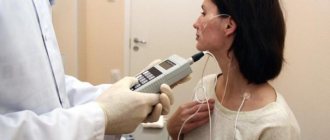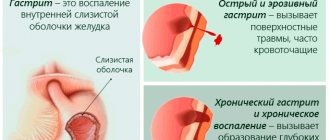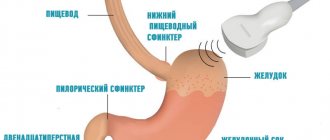Gastric ulcers have become a common diagnosis of our time, the reason being the rhythm of life and poor diet.
If the disease is not detected in time, irreversible complications cannot be avoided. The chronic form is very difficult to cure, so it is imperative to pay attention to the main warning symptoms.
What is a stomach ulcer?
A stomach ulcer is damage to the stomach lining. The defect is called an “ulcer”. It occurs in the upper third of the stomach, penetrating deeply into its wall. This is the most common gastrointestinal disease.
If the stomach wall bursts, its contents will enter the abdominal cavity, causing inflammation. An ulcer can provoke rupture of blood vessels, then bleeding is inevitable. The situation will require urgent medical attention.
The neglected disease becomes chronic with relapses in the autumn and spring. There are two types of ulcers:
- single;
- multiple (three or more), affect the deeper layers of the mucosa and leave scars during healing.
The main cause of gastric ulcers is an imbalance due to a violation of protective mechanisms against aggressive factors. It turns out that gastric mucus cannot cope with enzymes and hydrochloric acid.
History of the disease
The disease was first mentioned by Avicena in his treatise “The Canon of Medical Science”. He wrote that the ulcer eats away the walls of the stomach, causes bleeding and leads to death.
Ancient healers believed that the causes lay in a nervous state and irritability. In those days, the affected stomach was treated with herbs and diet.
Stomach ulcers were recognized as a serious diagnosis thanks to the fundamental research of the German professor Friedrich Uden. He described the disease while conducting experiments on domestic animals. In 1825, the French physician Jean Cruvelier proposed identifying ulcers as an independent disease and gave it a description that is still used by doctors.
In the 80s of the last century, a sensational discovery was made , which was later awarded the Nobel Prize. Doctors Bottcher and Lettulle discovered bacteria at the bottom of the stomach ulcer. Thus was born the theory of the infectious origin of the disease. Later, the microorganisms were named Helicobacter Pylori (HP), they were obtained by biopsy of a piece of the patient's gastric wall.
Many studies have been conducted based on the new theory. Until now, doctors around the world are discussing the connection with many diseases - ulcers, cancer, diabetes, autoimmune syndrome, etc. Two out of three people are carriers of harmful bacteria.
Statistics of the disease and its significance
Statistics indicate that 14% of the world's population suffers from stomach ulcers. In Russia, this figure is slightly lower – 10% (1% falls on children).
Most often, the disease affects men aged 20 to 40 years , they account for 70% of diagnosed cases. In the last decade, there has been a tendency to increase morbidity statistics among women.
A relationship has been established between the frequency of the disease and the following factors - gender, age, profession, place of residence. Even in regions of the same state, statistics will be different due to dietary patterns.
Risk factors
Among the patients, the leaders are young and middle-aged men with the first blood group . In women, the likelihood of developing ulcers during menopause increases due to a decrease in hormone levels in the body. Also at risk:
- heavy smokers;
- representatives of certain professions (transport workers, chemical industry workers, shoemakers);
- specialists working in shifts.
Mortality is 5% and is associated with complications of the disease - perforation, bleeding.
Radiology
Stomach ulcers can be identified using X-ray examination. The procedure may be prescribed as an alternative to FGDS. The accuracy of the method reaches 80%. There are direct radiological signs of ulcerative pathology. The main phenomenon is considered to be a “niche”. By niche, doctors understand a visually limited protrusion on the silhouette of the stomach filled with contrast.
If a niche is determined on the anterior/posterior wall of the organ, then it looks like a spot on the relief background of the mucosa. It is surrounded by a pronounced marginal shaft, caused by inflammation and swelling. The size of the niche is variable. Depends on two factors:
How to check the stomach without swallowing a tube?
- degree of damage to the gastric walls;
- the size of the inflammatory shaft.
The inflammatory shaft can visually lengthen the true size of the niche, as well as completely close it. The cavity itself sometimes turns out to be completely filled with food debris, mucus, and blood clots. That is why it can remain radiologically invisible.
In case of chronic ulcers prone to recurrence, as well as their callous forms, a modification of the relief of the gastric mucosa can be determined in the form of convergence of folds to a niche (scar changes). The combined detection of an inflammatory shaft and cicatricial changes indicate the presence of gastric ulcer (GUD).
Niches come in different sizes - small, medium, large. The acute period of ulcerative pathology is accompanied by the formation of a small notch. The most common size is 5 x 8 mm. Small niches, not exceeding the diameter of a pea, are localized in the duodenal bulb.
Most often, medium-sized niches are identified: 0.5...0.8 x 1.0...1.2 cm.
Large ulcerative niches, the depth and diameter of which exceed several centimeters, accompany chronic forms of the disease with pronounced symptoms. Formations of this size, in most cases, are penetrating ulcers. The penetrating niche is a niche that extends beyond the stomach into an organ located in close proximity.
It can be three-layered - barium, liquid, air - and two-layered - barium and an air layer. The presence of air bubbles on the x-ray is a clear sign of penetration. A niche of ulcerative origin almost always has smooth walls. If there are defects, we can talk about bleeding or the beginning of the process of degeneration.
The ulcer can be localized anywhere in the organ
Indirect signs of the presence of ulcers, for which the patient is prescribed an X-ray examination, are recognized as:
- dysphagia;
- stomach discomfort;
- bouts of vomiting;
- sudden weight loss;
- pain syndrome;
- the presence of a palpable compaction in the abdomen;
- determination of occult blood;
- anemic conditions;
- violation of secretory function.
For a more accurate diagnosis of stomach ulcers, the double contrast technique is used - the use of a contrast agent and air. After studying the motor function of the stomach and compensatory capabilities, the doctor prescribes treatment appropriate to the condition.
Causes of the disease
Scientists are inclined to believe that ulcers occur as a result of an imbalance between the protective factors of the mucous membrane and aggressive ones. Negative impacts include:
- infection of the mucous membrane with bacteria that destroy the cells of the mucous membrane (they account for 90% of cases);
- entry of intestinal contents into the stomach with bile components (duodenogastric reflux);
- increased content of hydrochloric acid and pepsin due to the abundance of gastric juice.
Relapse of the disease can be triggered by other factors:
- poor nutrition;
- bad ecology;
- stress and mental overload;
- high secretory activity;
- heredity (40% of cases);
- alcoholism;
- smoking;
- taking certain medications (diclofenac, aspirin, ibuprofen);
- complication of chronic diseases (tuberculosis, cirrhosis of the liver, lung cancer, diabetes, etc.).
Microorganisms are transmitted from the bacteria carrier in the following ways:
- from the mother during pregnancy;
- through saliva (kiss);
- through contaminated food and water;
- through dirty dishes;
- through poorly processed medical instruments.
Not all infected people develop ulcers. In some cases, a protective mechanism is triggered, the negative effects of microorganisms are neutralized by one’s own immunity and enzymes (bicarbonates, mucoproteins, prostaglandins).
Principles of therapy
Treatment of stomach ulcers is carried out in several directions.
- Elimination of the infectious agent.
- Reducing the acidity of gastric secretions.
- Regeneration of epithelial covers
Medications
The main groups of drugs used are:
- Proton pump inhibitors. A popular drug of the group is Omez.
- Drugs that block type 2 histamine receptors. In recent years, the group has become less used due to the increased effectiveness of proton pump inhibitors. The most famous representative is ranitidine.
- Antacid drugs are intended for symptomatic therapy, the effect is very short-term.
- Gastroprotectors – De-nol, Venter.
- Antimicrobial and antiprotozoal drugs to destroy the pathogen.
A variety of drug treatment regimens for peptic ulcer disease have been created, including antibiotics, trichopolum, and gastroprotectors. If ulcerative bleeding develops, the patient must be hospitalized in a surgical hospital and undergo intensive hemostatic therapy. What to do if you have a stomach ulcer - the final answer should be given by a qualified doctor - a gastroenterologist.
Nutrition correction
You should eat several times throughout the day, taking food in small portions. Eliminate foods that irritate the mucous membrane, alcohol, and coarse fiber from the diet. The diet of a patient with an ulcer should not contain spicy, sour, salty, or fried foods.
Milk, dairy products, egg whites, lean meats and poultry without skin and bones, slimy soups and porridges, and souffles are welcome in the diet.
Other recommendations
If an ulcer is open, it is strongly recommended to give up alcohol, cigarettes, and avoid physical overload and stressful situations. Smoking cigarettes irritates the mucous membranes of the stomach and intestines; the stomach becomes less resistant to factors that provoke ulcers. Substances contained in tobacco increase the secretion of hydrochloric acid and other aggressive components of gastric juice. Drinking alcohol can cause acute ulcers.
You should try to use non-steroidal anti-inflammatory drugs as little as possible. These drugs increase gastric secretion and can provoke the development of acute ulcers. If there is a need to take anti-inflammatory drugs, it is better to use paracetamol.
Traditional medicine methods are used in combination with traditional treatment. This method of treatment, such as drinking potato and carrot juice, is considered effective in treating ulcers.
An ulcer is a chronic disease that occurs when gastric juice affects damaged areas of the inner lining of the digestive tract. Stomach disease is not in every case accompanied by severe pain and severe symptoms, sometimes becoming fatal.
To avoid trouble, you need to learn how to identify a stomach ulcer at home based on signs of the general condition of the body, dyspeptic disorders, and pain syndromes.
Symptoms and diagnosis
A stomach ulcer has obvious signs, by which a doctor can easily diagnose it. The patient suffers from unpleasant symptoms:
emotional disorders (insomnia, anxiety, fatigue, thoughts of suicide, aggressiveness, depression);- stomach pain at night;
- increased appetite;
- thinness (due to fear of eating something);
- constant or periodically painful attacks in the sternum during meals (pain begins half an hour after a meal or on an empty stomach);
- pain in the back, ribs, near the navel (periodically);
- nausea with profuse vomiting (at the peak of digestion);
- constipation;
- heartburn;
- heaviness in the stomach (after meals and on an empty stomach);
- unpleasant stench from the mouth.
Most often, the disease develops in stages, but sometimes an asymptomatic course of the disease occurs . In the latter case, scars become a surprise during endoscopic examination.
Complications
Ulcerative lesions of the stomach are fraught with irreversible complications:
- stomach cancer (4% of cases of ulcer transformation into cancer);
- stenosis (significant narrowing of the outlet of the stomach during the process of scarring);
- bleeding;
- penetration (penetration of ulcers into nearby organs);
- perforation (inflammation of the peritoneum due to the entry of stomach contents into it).
Bringing any of these conditions to a critical point is fraught with death.
Diagnostics
If you experience one of the symptoms described above, you should immediately consult a doctor. The specialist will conduct an examination and prescribe the necessary examinations:
endoscopic examination (allows you to identify ulcers and determine their location, number, size, depth);- morphological analysis (microscopic examination);
- chromogastroscopy with dyes (determines gastric secretion);
- fluoroscopy with barium suspension (specifies the location of defects and their parameters);
- detection methods (tests and culture);
- survey radiography (to detect air in the abdominal cavity);
- pH-metry (assesses the acidity of the environment);
- endoscopic ultrasonography (detects thickening of the stomach wall).
In rare cases, an exacerbation occurs without symptoms or with mild signs. Therefore, patients with a chronic diagnosis should undergo regular examinations and monitor their diet.
Types of ulcers
Defects are divided according to their location:
- duodenal ulcers (subbulbous, bulbous);
- stomach ulcers (gastric body, pyloric canal, cardinal and antrum);
- combined ulcers (2 types at the same time).
Defects can be large (more than 2 cm) and gigantic (diameter more than 3 cm). The disease progresses in stages:
- exacerbation phase (relapse);
- decay phase;
- remission phase.
The type of disease and its phase can only be determined by a comprehensive examination of the gastrointestinal tract.
How to recognize an open ulcer
To diagnose the disease, a gastroenterologist carefully examines characteristic complaints and anamnestic information. After carefully questioning and examining the patient, the doctor prescribes a number of diagnostic procedures.
- Fibrogastroduodenoscopy is an examination in which a special device, an endoscope, is inserted into the patient’s stomach. The device is a thin fiber optic tube with a camera and a light source at the tip. The doctor uses an endoscope to examine the inner surface of the walls of the stomach, esophagus and duodenum. The location of the ulcer, the presence of bleeding vessels and possible complications are determined. To exclude malignancy, a tissue sample is taken for histological examination. Using a histological examination, it will be possible to determine the presence of bacteria in the stomach - the causative agents of peptic ulcer disease. Often, endoscopy is used to cauterize small ulcers, erosions, and stop bleeding.
- If perforation of the ulcer is suspected, a plain X-ray is taken. To clarify the diagnosis, it is possible to conduct an X-ray contrast study using a barium suspension.
- A variety of diagnostic tests are performed to determine the presence of the bacterium Helicobacter pylori.
Treatment
Most patients undergo outpatient therapy. Hospitalization is required only in cases of severe pain and suspected complications. Complex treatment is used.
Medicines
Modern pharmaceuticals offer a number of effective antiulcer agents, which are the basis for adequate therapy. These include drugs from the following groups:
- psychotropic (seduxen, elenium);
- reparants for the restoration of the mucous membrane (solcoseryl, acemin, etadene);
- gastrocytoprotectors to increase the resistance of the mucous membrane (sucralfate, smecta, vikair);
- HP blockers (tetracycline, metronidazole, levofloxacin);
- secretolytics to reduce the production of hydrochloric acid (methacin, famotidine, omeprazole);
- antacids to relieve muscle spasms (Protab, Gastal, Gaviscon).
Eradication therapy together with secretolytics plays a key role. The remaining medications are additions to the course of treatment, which lasts from 2 to 8 weeks depending on the nature of the ulcers.
Surgical intervention
Surgical intervention is required for patients with peptic ulcer if treatment does not give the desired result and in case of complications.
If bleeding occurs, the surgeon stitches the damaged vessel or performs a resection of the gastric area with a defect. In case of perforation development, it is permissible to use several methods - vagotomy, suturing, resection. In case of stenosis, a gastrojejunostomy is performed on the patient's stomach.
Diet
Patients with stomach ulcers are advised to follow strict dietary rules:
- rest of the mucous membrane after a meal;
- give preference to small portions;
- exclude foods that provoke the secretion of gastric juice;
- eat meals once every three hours (this will allow food to be digested faster and easier);
- the maximum daily dose of salt is 10 g;
- do not eat too hot or cold foods;
- choose dishes that are soft and delicate in consistency.
Prohibited:
- some vegetables (cabbage, tomatoes, legumes, radishes);
- fruits (citrus fruits, dates);
- berries (gooseberries, cranberries);
- spices;
- drinks (alcohol, coffee, cocoa, chocolate);
- hot sauces;
- fried and spicy foods;
- canned food;
- meat broth;
- wholemeal bread.
Phytotherapy
Drug treatment is combined with traditional medicine recipes. Herbal teas will help relieve the following symptoms:
- normalize stool;
- stimulate the healing of ulcers;
- nourish and protect the mucous membrane from aggressive factors;
- relieve pain;
- reduce inflammation.
Certain herbs are suitable for these purposes:
mint, St. John's wort, calendula, chamomile, yarrow, dill, oregano, licorice, flaxseed, elecampane, chicory, burdock root, rhubarb, zoster.
Infusions, decoctions, applications and medicinal baths are prepared from the above-mentioned herbs. Herbal medicine is prohibited if the patient has bleeding, fever, or cancer.
Prevention
Preventive measures are aimed at preventing the formation of ulcers. To prevent this you need to:
- prevent bacterial infection (observe hygiene rules);
- support immunity;
- adhere to a healthy diet (reduce the amount of fried and spicy foods, eat often and in small portions);
- treat provoking diseases in a timely manner;
- observe a sleep and rest schedule (at least 8 hours);
- do not be overloaded with physical and mental stress;
- avoid stress;
- comply with the dosage of prescribed medications.
If the diagnosis has already been made, you should not aggravate your condition. To do this you need:
- see a doctor regularly;
- undergo therapeutic courses as necessary (especially during exacerbation seasons);
- follow a diet;
- relax in a sanatorium.
Video on the topic: 5 rules for protecting yourself from stomach ulcers
Forecast
The prognosis for recovery from peptic ulcer disease is favorable if the disease is detected in a timely manner. If the diagnosis was made correctly at an early stage and adequate therapy was completed, the patient will recover. If necessary, surgical intervention is performed with the consent of the patient.
An unfavorable prognosis if the disease has caused irreversible complications - 5% are fatal. They speak of complete remission if the disease has not made itself felt for more than 3 years. This should be confirmed by a full examination.
It is always easier to prevent a disease than to fight it later and “bite your elbows.” Therefore, it is worth listening to the signals that the body gives and undergoing appropriate examination so as not to develop a peptic ulcer.
Diagnosis of gastric diseases. Which specialist should I contact?
Important! Only a qualified specialist, based on an analysis of all the symptoms described above, can suggest one or another diagnosis. In the future, additional laboratory or instrumental studies are prescribed to confirm or refute it.
Stomach diagnostic methods
To make a correct diagnosis and prescribe adequate treatment, the doctor will need data on the condition of the gastric mucosa, the composition of gastric juice, and the tone of the pylorus.
If you experience one or more of the above complaints, you should contact your physician, family doctor or general practitioner. He will prescribe the necessary studies and, if necessary, recommend contacting a specialized specialist. A good option would be to independently contact a specialist who treats gastric diseases - a gastroenterologist. For nausea and abdominal pain, read our article.











